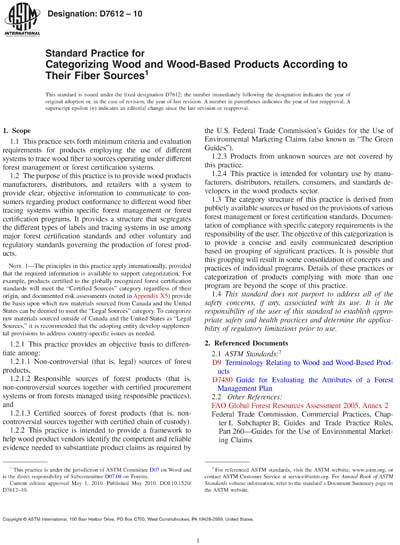Historical
ASTM D7612-10
Standard Practice for Categorizing Wood and Wood-Based Products According to Their Fiber Sources
1.1 This practice sets forth minimum criteria and evaluation requirements for products employing the use of different systems to trace wood fiber to sources operating under different forest management or forest certification systems.
1.2 The purpose of this practice is to provide wood products manufacturers, distributors, and retailers with a system to provide clear, objective information to communicate to consumers regarding product conformance to different wood fiber tracing systems within specific forest management or forest certification programs. It provides a structure that segregates the different types of labels and tracing systems in use among major forest certification standards and other voluntary and regulatory standards governing the production of forest products.
Note 1—The principles in this practice apply internationally, provided that the required information is available to support categorization. For example, products certified to the globally recognized forest certification standards will meet the “Certified Sources” category regardless of their origin, and documented risk assessments (noted in Appendix X5) provide the basis upon which raw materials sourced from Canada and the United States can be deemed to meet the “Legal Sources” category. To categorize raw materials sourced outside of Canada and the United States as “Legal Sources,” it is recommended that the adopting entity develop supplemental provisions to address country-specific issues as needed.
1.2.1 This practice provides an objective basis to differentiate among:
1.2.1.1 Non-controversial (that is, legal) sources of forest products,
1.2.1.2 Responsible sources of forest products (that is, non-controversial sources together with certified procurement systems or from forests managed using responsible practices), and
1.2.1.3 Certified sources of forest products (that is, non-controversial sources together with certified chain of custody).
1.2.2 This practice is intended to provide a framework to help wood product vendors identify the competent and reliable evidence needed to substantiate product claims as required by the U.S. Federal Trade Commission’s Guides for the Use of Environmental Marketing Claims (also known as “The Green Guides”).
1.2.3 Products from unknown sources are not covered by this practice.
1.2.4 This practice is intended for voluntary use by manufacturers, distributors, retailers, consumers, and standards developers in the wood products sector.
1.3 The category structure of this practice is derived from publicly available sources or based on the provisions of various forest management or forest certification standards. Documentation of compliance with specific category requirements is the responsibility of the user. The objective of this categorization is to provide a concise and easily communicated description based on grouping of significant practices. It is possible that this grouping will result in some consolidation of concepts and practices of individual programs. Details of these practices or categorization of products complying with more than one program are beyond the scope of this practice.
1.4 This standard does not purport to address all of the safety concerns, if any, associated with its use. It is the responsibility of the user of this standard to establish appropriate safety and health practices and determine the applicability of regulatory limitations prior to use.
Content Provider
ASTM International [astm]






